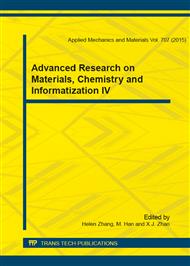[1]
MOHANTY J R, VERMA B B, RAY P K: International Journal of Fatigue, 2009, 31(3): 418−424.
Google Scholar
[2]
MOHANTY J R, VERMA B B, RAY P K: International Journal of Fatigue, 2009, 31(3): 425−432.
Google Scholar
[3]
LEMAITRE J: Nuclear Engineering and Design, 1984, 80(2): 233−245.
Google Scholar
[4]
XIAO Y C, LI S, GAO Z: International Journal of Fatigue, 1998, 20(7): 503−508.
Google Scholar
[5]
DESMORAT R, KANE A, SEYEDI M: European Journal of Mechanics: A/Solids, 2007, 26(6).
Google Scholar
[6]
Chaboche JL, Lesne PM: Fatigue and Fracture of Engineering Materials and Structures, 1988, 11(1): 1-7.
Google Scholar
[7]
Kim TW, Kang DH, Yeom JT, etc: Scripta Materialia, 2007, 57: 1149-1152.
Google Scholar
[8]
Krajcinovic D, Lemaitre J: Continum damage mechanics theory and applications (Wien: Springer-Verlag, 1987).
Google Scholar
[9]
Lemaitre J: A course on damage mechanics (Springer, 1996).
Google Scholar
[10]
Lemaitre J, Desmorat R: Engineering damage mechanics (Berlin: Springer, 2005).
Google Scholar
[11]
Dattoma V, Giancane S, Nobile R, etc: Int.J. Fatigue, 2006, 28: 85-95.
Google Scholar
[12]
Desmorat R, Gatuingt F, Ragueneau F: Engineering Fracture Mechanics, 2007, 74(10): 1539-1560.
DOI: 10.1016/j.engfracmech.2006.09.012
Google Scholar
[13]
Desmorat R, Kane A, Seyedi M, etc: European Journal of Mechanics-A/ Solids, 2007, 26(6): 909-935.
Google Scholar
[14]
Desmorat B, Desmorat R: Comptes Rendus Mecanique, 2008, 336(5): 448-453.
DOI: 10.1016/j.crme.2008.01.001
Google Scholar
[15]
Kachanov LM: Izv A Rad Nauk SSSR otd Tekh Nauk, 1958(8): 23-31.
Google Scholar
[16]
Lemaitre J, Desmorat R: Engineering damage mechanics (Berlin: Springer, 2005).
Google Scholar
[17]
Fengping Yang , Qin Sun, Jinheng Luo, Hua Zhang: Chinese Journal of Theoretical and Applied Mechanics, 2012, 44(001): 140-147.
Google Scholar
[18]
Weixing Yao: Fatigue Life Prediction of Structures (Peking:National Defence Industry Press, 2004( In Chinese).
Google Scholar
[19]
Minggao Yan, Bocao Liu, Jingui Li et al: China Aeronautical Materials Handbook, Part Ⅲ (Peking:China Standard Press, 2002. 39-83(In Chinese).
Google Scholar
[20]
Yuya Wang, Enhou Han, Qunzhi Chen: Journal of Mechanical Strength, 2004, 26(S): 163-164(In Chinese).
Google Scholar
[21]
Liu Jianxiu, Ding Suiliang: Journal of Mechanical Strength. 1999, 21(2): 157-158(In Chinese).
Google Scholar
[22]
Gao Zhentong, Liu Zhijing, Jia Guorong, Handbook of fatigue properties of Aeronautical Materials (Peking:Beijing Institute of Aeronautical Materials, 1981(In Chinese).
Google Scholar


